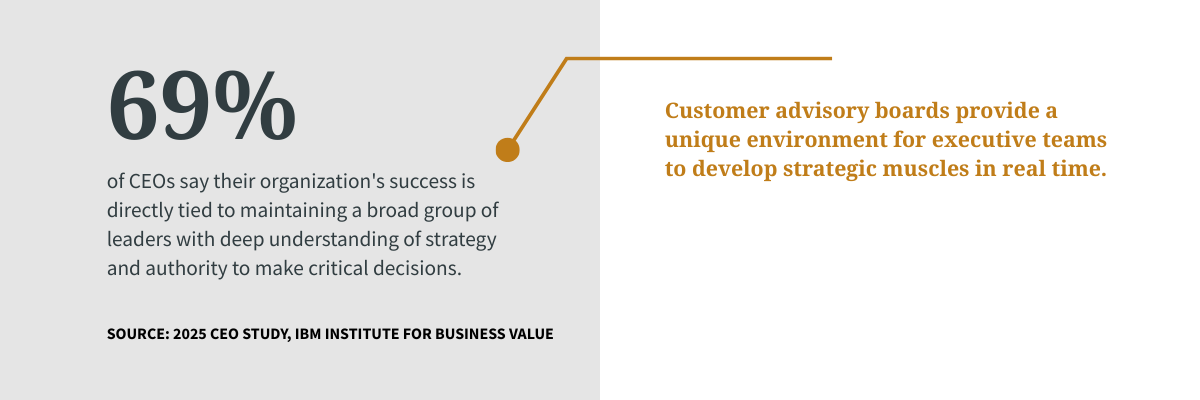Building a Leadership Brain Trust: How Customer Advisory Boards Strengthen Executive Teams
In the recently released CEO Study by the IBM Institute for Business Value, a striking 69% of CEOs believe “their organization's success is directly tied to maintaining a broad group of leaders with deep understanding of strategy and authority to make critical decisions.”
While customer advisory boards are often viewed primarily through the lens of gaining customer insights and strengthening strategic relationships, there's another powerful dimension that sometimes goes unrecognized: their role in developing and strengthening your executive leadership team.
Beyond the CEO: The Whole Team Advantage
Customer advisory boards provide a unique environment where executive teams can develop their strategic muscles in real time. When properly structured, these boards expose your full leadership team to high-level strategic discussions with your most important customers, creating a shared experience that builds capabilities across your organization.
We consistently observe that the most impactful programs engage a broad set of internal leaders, not just the CEO or board sponsor. This broader engagement serves several key purposes:
Creates alignment around customer priorities - When multiple executives hear the same customer feedback directly, it eliminates the game of "telephone" that often dilutes customer insights as they travel through an organization.
Builds strategic thinking capabilities across functions - Marketing leaders gain insights into operational challenges, while technology leaders develop deeper appreciation for customer experience concerns. These cross-functional insights strengthen the entire team's ability to think holistically.
Fosters a culture of accountability - When executives make commitments in front of customers, they create powerful motivation to follow through—and their peers help hold them accountable.
The Leadership Development Cycle
The value of advisory boards as leadership development vehicles extends throughout the board cycle—from preparation through action.
1) Meeting Preparation that Encourages Clarity and Collaboration
Preparing effectively for advisory board meetings requires executives to:
Distill complex ideas into clear, strategic questions
Articulate challenges honestly without becoming defensive
Balance vulnerability with confidence
These preparation activities alone build valuable leadership muscles. I've observed many leadership teams struggle with their first board presentations, often falling into the trap of creating dense, product-focused slides rather than open-ended strategic frameworks that invite collaboration. But with coaching and experience, these same teams develop remarkable skills at framing conversations strategically.
2) In-meeting Participation that Builds Capability
During advisory board meetings, executives practice several key leadership competencies:
Active listening - Absorbing customer insights without immediately jumping to solutions
Synthesis - Identifying patterns and themes across diverse customer perspectives
Constructive response - Engaging with challenging feedback productively
Strategic agility - Adapting approaches based on real-time customer input
One particularly powerful development opportunity occurs when executives must navigate unexpected feedback or challenging questions from board members. These moments, though sometimes uncomfortable, create exceptional growth opportunities that simply cannot be replicated in internal meetings.
3) Post-meeting Action that Cements Development
After advisory board meetings, the development cycle continues as leadership teams:
Interpret and prioritize feedback - Determining which insights merit immediate action
Translate insights into operational plans - Moving from strategic discussions to tactical implementation
Communicate outcomes throughout the organization - Cascading lessons and insights from inside the board room to broader teams
Track and report on progress - Creating accountability mechanisms for commitments made
This complete cycle—from preparation through action—creates a comprehensive development vehicle for leadership teams completely distinct from traditional executive education programs or internal meetings.
Designing Board Interactions for Leadership Development
While leadership development often occurs organically through board participation, you can intentionally design your program to amplify these benefits:
Understand participating leaders’ individual priorities and goals and discuss how board participation may support them
Curate session topics that require cross-functional leadership aligned with strategic priorities
Rotate presentation responsibilities across your leadership team to give different executives exposure
Pair different internal leaders with diverse board members in structured breakout discussions
Create opportunities for less experienced leaders to present alongside more seasoned executives
Incorporate working sessions that allow executives to collaborate directly with board members on specific challenges
Schedule dedicated debrief sessions immediately following board meetings to capture what you learned while it’s still fresh
Provide targeted coaching for executives before and after meetings
When designing these interactions, remember that the most effective development occurs when executives must move beyond their comfort zones—whether that means the marketing leader engaging in discussions about operational efficiency or the technology leader addressing customer experience concerns.
Measuring Leadership Growth Through Board Engagement
How can you tell if your leadership team is developing through board participation? Discuss with the team:
Presentation evolution - Are our executive presentations becoming more strategic and dialogue-focused over time?
Question quality - Are we asking more insightful questions of board members?
Cross-functional collaboration - Do we observe increased collaboration between different functional leaders after board meetings?
Action follow-through - Are we more effective at translating board insights into action?
Strategic language adoption - Are we incorporating customer language and priorities into their regular communications?
The Board as Leadership Testing Ground
Perhaps most importantly, advisory boards provide a unique testing ground where executives can refine their strategic thinking and communication in a high-stakes but supportive environment. Presenting to senior executives from your customer organizations raises the bar for preparation and performance, while still providing a more forgiving environment than broad market initiatives.
As IBM's study highlights, CEOs today need leaders who can navigate uncertainty with confidence. Advisory boards create precisely the environment where leadership teams can practice this navigation, building the muscle memory they'll need when facing broader market challenges.

